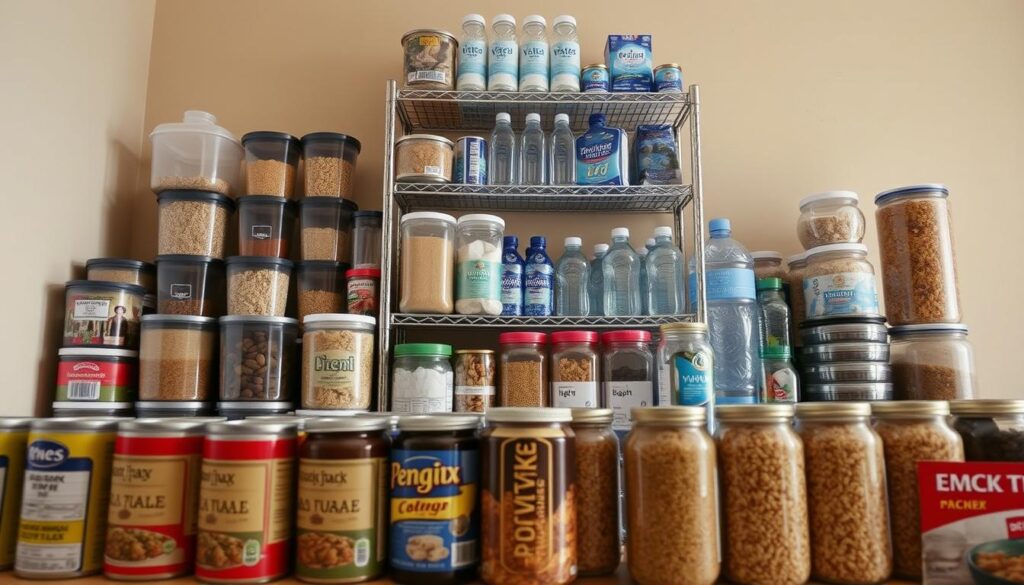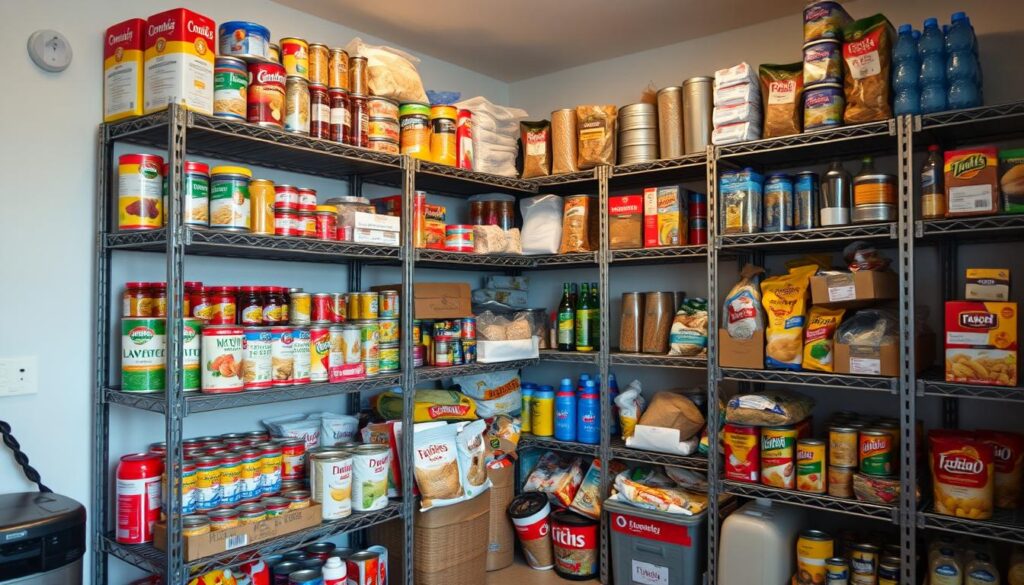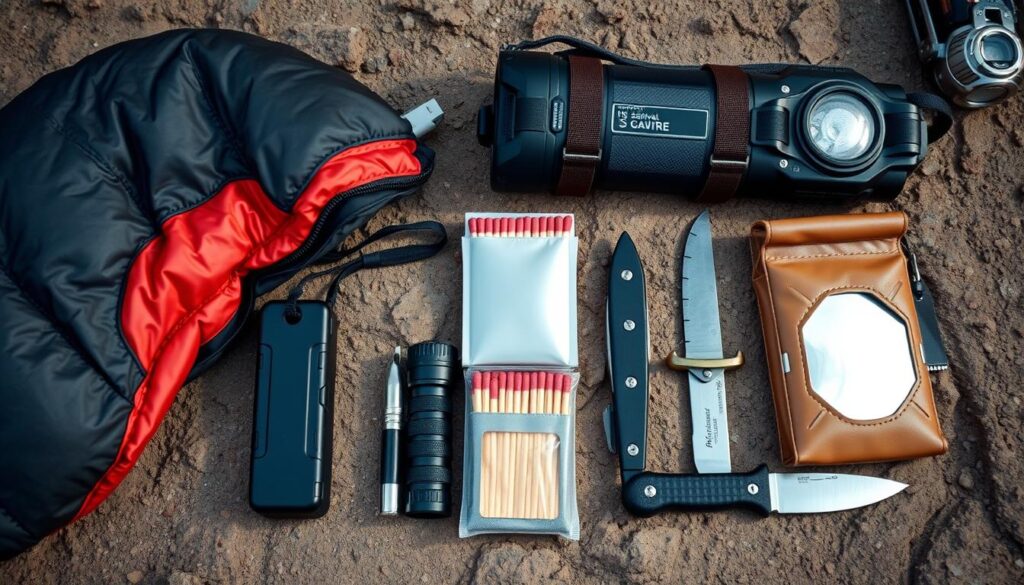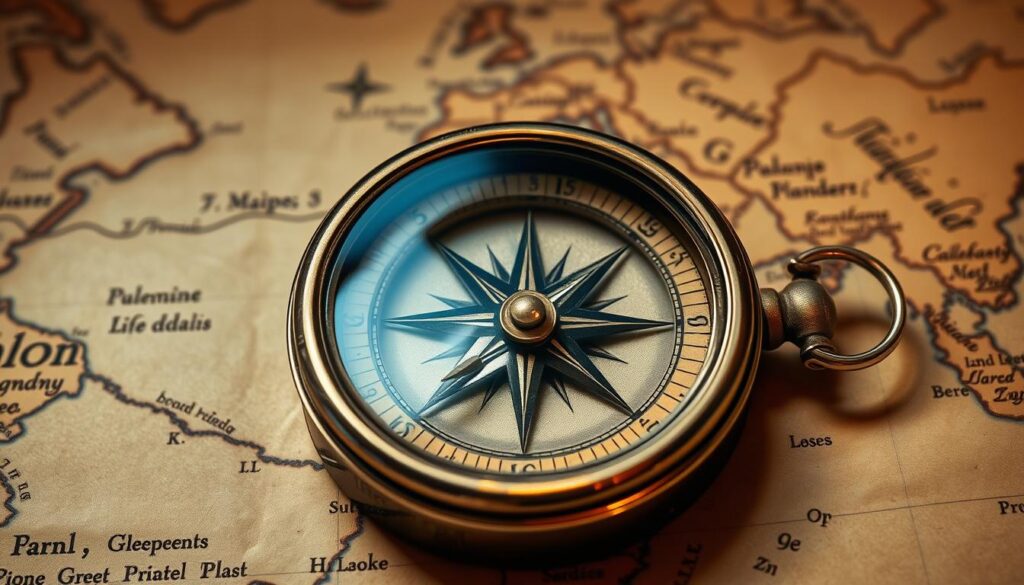Creating an emergency food stash is key to being ready for unexpected disasters. In this guide, I’ll show you how to make a self-sufficient emergency food supply for your home.
A well-planned stash can reduce stress and make sure you and your family eat well in tough times. Elizabeth Andress and Judy Harrison, authors of “Preparing an Emergency Food Supply, Short Term Food Storage,” say planning can ease worries and make life easier.
Key Takeaways
- Understand the importance of having an emergency food stash.
- Learn how to build a self-sufficient emergency food supply.
- Discover the benefits of having a well-planned food stash.
- Identify the essential steps to create an emergency food stash.
- Start preparing for unexpected disasters or crises.
Understanding the Importance of an Emergency Food Supply
A well-planned emergency food supply is key to navigating disasters and emergencies with confidence. Having a reliable source of nutrition can significantly impact your ability to cope with unexpected situations.
Experts like Elizabeth Andress and Judy Harrison say food storage is vital for emergencies and natural disasters. It’s not just about stockpiling food. It’s about ensuring you and your family have nutritious meals during crises.
Reasons for Building a Food Stash
Building a food stash is essential for several reasons. It provides sustenance during natural disasters, economic crises, or other emergencies when grocery stores may be out of reach. A well-stocked food supply can also reduce stress during uncertain times.
When building your emergency food stash, consider the needs of all household members, including any special dietary requirements. This ensures everyone has access to the right nutrition, no matter the situation.
How an Emergency Food Supply Can Save You
An emergency food supply can be a lifesaver in critical situations. For example, during a prolonged power outage or natural disaster, having a stockpile of survival food kits can provide the necessary sustenance until help arrives or until normal supplies are restored.
Also, having a well-planned emergency food supply can help you save money. It allows you to buy food in bulk and avoid last-minute, often more expensive, purchases during emergencies.
Personal Experiences and Lessons Learned
From my personal experience, having an emergency food supply in place has provided peace of mind during uncertain times. It’s not just about the food; it’s about being prepared for the unexpected.
One of the key lessons learned is the importance of regularly checking and updating your emergency food stash. This includes checking expiration dates and ensuring the food stored meets the dietary needs of all household members.
| Benefits of Emergency Food Supply | Description |
|---|---|
| Nutritional Support | Provides necessary nutrition during emergencies |
| Stress Reduction | Helps alleviate stress associated with food scarcity |
| Financial Savings | Allows for bulk purchasing, reducing long-term costs |
Assessing Your Emergency Food Needs
Knowing what food your household needs in an emergency is key. You must think about several important things. These will help you figure out how much and what kind of food to store.
Factors to Consider for Your Household
Start by looking at how many people live in your home, their ages, and any health issues. The food you store depends on these factors. It also depends on what you like to eat and how you can use the food in an emergency.
- Number of household members
- Ages and health conditions of household members
- Personal food preferences
- Ability to prepare and consume food during emergencies
Understanding Nutritional Requirements
A balanced diet is very important, even in emergencies. Knowing what your family needs nutritionally is key. For example, kids, pregnant women, and people with certain health issues might need different foods.
Nutritional requirements to consider include:
- Caloric intake
- Protein sources
- Vitamins and minerals
- Foods that are easy to prepare
Considering Dietary Restrictions
It’s also important to think about any dietary restrictions. This could be because of health issues, personal choice, or religious beliefs. This includes vegetarian, gluten-free, dairy-free, and other special diets.
“The amount and types of food to store depend on household members, preferences, special health conditions, ability to use the food in an emergency, and storage space.” – Elizabeth Andress and Judy Harrison, “Preparing an Emergency Food Supply, Short Term Food Storage”
By thinking about these things, you can make a better emergency food plan for your family.

Creating a List of Essential Non-Perishables
Starting an emergency food stash means picking out key non-perishables. These foods should keep you and your family going during tough times. They need to be nutritious, easy to make, and last a long time.
When making your list, think about different food types. Include canned meats, fruits, and veggies, along with juices, milk, and soups. Don’t forget sugar, salt, pepper, and high-energy foods like peanut butter and granola bars.
Categories of Food to Include
Your emergency food supply should have a variety of foods for good nutrition. Elizabeth Andress and Judy Harrison suggest including:
“Ready-to-eat canned meats, fruits, and vegetables, canned juices, milk, and soup, staples like sugar, salt, and pepper, and high-energy foods like peanut butter and granola bars.”
These food groups are a good start. Remember to pick foods you like and that fit your diet.
Recommended Brands for Long Shelf Life
Choosing brands for your emergency food is important. Look for ones known for lasting a long time. Some top brands are:
| Brand | Product Category | Shelf Life |
|---|---|---|
| Mountain House | Freeze-dried meals | Up to 30 years |
| Augason Farms | Canned goods, dehydrated meals | Up to 25 years |
| ReadyWise | Freeze-dried meals, emergency rations | Up to 25 years |
How to Prioritize Your List
When making your list, think about what you need to eat, how easy it is to prepare, and what you like. Start with foods that are full of protein and calories. Then, pick items that are simple to make, or don’t need cooking at all.
Prioritization Steps:
- Identify nutritional needs and preferences.
- Assess the ease of preparation for each item.
- Consider the shelf life and storage requirements.
By following these steps, you can make a great emergency food supply that fits your needs.
Choosing the Right Storage Solutions
The key to a good emergency food supply is choosing the right storage solutions. You need the right containers, the best storage conditions, and a way to keep everything organized and easy to find.
Types of Containers for Food Storage
Choosing the right container for emergency food is very important. Containers must be airtight and moisture-proof to keep food safe. You can use plastic buckets, glass jars, or Mylar bags. Each has its own benefits, depending on the food and space you have.
| Container Type | Advantages | Disadvantages |
|---|---|---|
| Plastic Buckets | Durable, easy to seal, and stackable | Can be prone to pest infestation if not sealed properly |
| Glass Jars | Non-porous, easy to clean, and pest-resistant | Heavy, prone to breakage, and can be expensive |
| Mylar Bags | Lightweight, compact, and moisture-proof | Can be punctured easily, requires additional packaging for protection |
Ideal Storage Conditions for Your Stash
It’s important to store your emergency food in a cool, dry place. This keeps it fresh longer. The “Emergency Preparedness Manual” by The Church of Jesus Christ of Latter-Day Saints says to store food in airtight containers in cool, dark places.

Labeling and Organizing Your Supply
Labeling and organizing your emergency food is key. Use clear labels to show what’s inside, when it was stored, and how to cook it. Organize it so you can use the oldest items first. This keeps your food fresh and ready to use.
- Label containers clearly with contents and storage date
- Store food in a way that allows for easy access to the oldest items
- Keep a inventory list to track your supplies and monitor expiration dates
By choosing the right storage solutions and taking care of your emergency food, you’ll have a reliable resource when you need it.
Where to Purchase Emergency Food Supplies
Finding a reliable place to buy emergency food supplies is key for preppers and anyone wanting to be ready for anything. It’s important to have a trusted source for these supplies.
There are many places to buy emergency food. Local stores are a good start because you can get things right away and check the products first.
Local Options for Food Stash Items
Local grocery stores, supermarkets, and wholesale clubs are great for emergency food. They have lots of non-perishable items like canned goods, dried fruits, and MREs. You can see the products and check when they expire, making sure they’re fresh.
Local farmers’ markets are also good for fresh produce. You can can or freeze this produce to keep it longer.
Online Resources and Providers
Online shopping is convenient if you can’t get to local stores. Many websites sell emergency food with long shelf lives. Some even offer survival food kits and bundles for different needs.
When buying online, check the seller, read reviews, and look at the product’s shelf life and nutrition. This ensures you get a good product.
Bulk Buying: Pros and Cons
Buying in bulk can save money and be easy. But, it’s important to think about the downsides. Bulk buys can save money and cut down on shopping trips. Yet, they need a lot of space and can go bad if not stored right.
To get the most from bulk buying, organize your storage well. Always check expiration dates and use a rotation plan. This way, older items get eaten before they expire.
Building Your Stockpile Step by Step
Starting to build my emergency food stockpile was a big step. I learned that it’s best to do it step by step. This makes the task easier and more manageable.
The “Emergency Preparedness Manual” by The Church of Jesus Christ of Latter-Day Saints says that building a stockpile requires creating a budget, phasing in purchases, and tracking inventory. This method helps manage resources well. It also keeps the stockpile useful and up-to-date.
Creating a Budget for Your Supplies
The first thing to do is create a realistic budget for your emergency food. You need to figure out how much you can spend each month. It’s important to balance your stockpile with your current financial needs.
Having a good budget helps you spend wisely. It lets you build your stockpile without breaking the bank. As guides say,
“A budget is not just about cutting expenses; it’s about making conscious financial decisions that align with your priorities.”
Phasing in Your Purchases
After setting your budget, start phasing in your purchases. Begin with the most important items. These are the basics like non-perishable food, water, and cooking supplies.
- Start with the basics: non-perishable food items and water.
- Gradually add more variety to your stockpile.
- Consider the nutritional value and shelf life of the items you purchase.
Tracking Your Inventory Effectively
Tracking your inventory is key to a good stockpile. It helps you know what you have, what needs to be replaced, and what’s about to expire. Use a spreadsheet or inventory tool for this.

Regularly updating your inventory keeps your stockpile fresh and ready. This step is important to avoid waste. It makes sure your emergency food is always good to use.
Rotation and Maintenance of Your Food Stash
To keep your emergency food supply effective, it’s key to have a rotation and maintenance plan. Experts like Elizabeth Andress and Judy Harrison stress the importance of regular rotation and maintenance. This ensures your emergency food stays safe and nutritious.
Basics of Food Rotation
Rotating your food stash means using the oldest items first and replacing them with new ones. This keeps your emergency food fresh and ready when you need it. A simple first-in, first-out (FIFO) system works well for managing your stash.
To use a FIFO system, mark each item with its purchase date. Start with the oldest items when it’s time to use or replace them. This keeps your emergency food in top condition.
Expiration Dates and Shelf Life
Knowing about expiration dates and shelf life is vital for a safe emergency food stash. Expiration dates show the last safe date to eat a product. Shelf life is how long a product stays good.
| Food Type | Typical Shelf Life | Storage Tips |
|---|---|---|
| Canned Goods | 2-5 years | Store in a cool, dry place |
| Freeze-Dried Meals | 25-30 years | Keep away from moisture and direct sunlight |
| MREs (Meals Ready to Eat) | 3-5 years | Store in a dry, cool area, away from extreme temperatures |
Conducting Regular Inventory Checks
Regular checks of your emergency food stash are a must. They help spot expired or spoiled items that need to be replaced. It’s also a chance to make sure your stash meets your dietary needs and tastes.
To do a good inventory check, sort your supplies first. Then, go through each group, checking expiration dates and item condition. Make a list of what needs to be replaced or added. Use this list to update your rotation plan.
Incorporating Fresh Foods into Your Supply
A good emergency food supply isn’t just canned goods. It also includes fresh foods that stay safe and edible. Non-perishable foods are key, but fresh foods add variety and nutrition.
There are ways to add fresh foods to your emergency stash. You can freeze, can, or even grow your own emergency garden. Each method works well and fits different needs and resources.
Freezing vs. Canning: What to Choose?
Freezing and canning are top choices for keeping fresh foods. Freezing keeps nutrients in foods like veggies, meats, and fruits. But, it needs a working freezer and power. Canning heats food to kill bacteria and seals it in containers, great for long storage without fridge.
| Preservation Method | Advantages | Disadvantages |
|---|---|---|
| Freezing | Preserves nutritional value, retains flavor and texture | Requires a reliable freezer and power supply |
| Canning | Long-term storage without refrigeration, versatile | Requires careful attention to sterilization and sealing |
For more on building your food storage, check out this resource.
Growing Your Own Emergency Garden
Starting an emergency garden is a smart way to add fresh foods. Growing fruits, veggies, and herbs ensures a steady supply. Pick easy-to-grow crops for tough conditions.
Foraging Basics for Beginners
Learning to forage for wild foods is useful in emergencies. It’s about finding and picking edible plants, fruits, and nuts. Beginners should learn about common edible plants and safety to avoid poisonous ones.
Adding fresh foods to your emergency stash takes planning and effort. But, it boosts nutrition and well-being during tough times.
Preparing for Different Types of Emergencies
Emergency preparedness is not a one-size-fits-all solution. It needs to be tailored to the specific emergencies you might face. Different emergencies, like natural disasters or man-made crises, need different emergency food plans.
When preparing for emergencies, think about the disasters that could hit your area. For example, if you live in a hurricane-prone area, your food supply must withstand strong winds and flooding.
Natural Disasters and Food Needs
Natural disasters like earthquakes, hurricanes, and floods can cut off your food and water access. It’s key to stock non-perishable food items that don’t need electricity to prepare.
- Canned goods
- Dried fruits and nuts
- MREs (Meals Ready to Eat)
Man-Made Crises: Considerations
Man-made crises, like industrial accidents or cyberattacks, can also mess with food supplies. Having a food stockpile that doesn’t need complex infrastructure can be a lifesaver.
| Food Type | Shelf Life | Preparation Requirements |
|---|---|---|
| Canned Vegetables | 2-5 years | Can opener |
| Dried Legumes | 10+ years | Cooking facility |
| MREs | 3+ years | None (self-contained) |
Long-term Power Outages Planning
Long-term power outages can mess with your food storage and preparation. Having a plan for cooking and storing food without power is essential.
Think about getting a portable generator or a solar-powered cooking solution. This way, you can keep making meals.
Tips for Working with Limited Space
Even with little space, you can stock up on emergency food with some creativity. The trick is to use your space wisely with smart storage ideas.
Using multi-purpose solutions is a great way to save space. For example, you can find storage containers that also serve as furniture or decor. This not only saves room but also keeps your emergency food ready when you need it.
Multi-Purpose Solutions for Small Areas
In small spaces, it’s key to pick storage that does more than one thing. Think about using:
- Storage ottomans that hold food and offer extra seating.
- Under-bed containers for storing dry food.
- Stackable plastic bins for various food supplies.
Creative Ideas for Storing Food
Being creative with food storage can really help in tight spots. Here are some ideas:
- Use magnetic spice strips on fridges or metal cabinets for small items.
- Put up shelves or storage in pantries or closets.
- Use decorative containers or baskets to hide food in plain sight.
Utilizing Vertical Space Effectively
Maximizing vertical space is vital when space is tight. Consider:
- Wall-mounted shelves for canned goods or dry items.
- Stackable containers or bins for easy labeling.
- A pegboard system for hanging baskets or utensils.
Here’s a simple comparison of different storage solutions:
| Storage Solution | Space Efficiency | Ease of Access |
|---|---|---|
| Under-bed storage | High | Moderate |
| Wall-mounted shelves | High | Easy |
| Stackable bins | Moderate | Easy |
By using these strategies, you can build a big emergency food stash, even in the smallest spaces.
My Emergency Food Plan Review
It’s important to regularly check and update my emergency food plan. This is key, as “Preparing an Emergency Food Supply, Short Term Food Storage” by Elizabeth Andress and Judy Harrison points out. I make sure my first aid kit and emergency food are up to date for our family’s needs.
Evaluating My Supplies
I check my emergency food to make sure it has a mix of non-perishable items. I also think about any special diets we might have. This helps me see what needs to be changed in our plan.
Adjusting to Changing Needs
When our family’s needs change, I update our emergency food. This means adding new items for any special diets we might have.
Family Feedback
I ask my family for their thoughts on our emergency food plan. This makes sure everyone knows what to do in an emergency. Working together keeps our food supply ready for us.
By keeping an eye on our emergency food plan, I know we can count on it when we need it.
FAQ
What is the most important thing to consider when building an emergency food supply?
Think about how many people live in your home and their food needs. Also, remember any special diets they might have.
How do I choose the right storage solutions for my emergency food supply?
Pick containers that keep air and moisture out. Store them in a cool, dry spot. Label and organize them well to keep track.
Where can I purchase emergency food supplies?
You can buy them at local stores, online, or at stores for preppers and survivalists.
How often should I rotate my emergency food stash?
Check expiration dates and shelf life often. Replace or use up items as needed. Regular checks help you stay updated.
Can I incorporate fresh foods into my emergency food supply?
Yes, you can freeze, can, grow, or forage for foods. This adds variety and nutrition to your stash.
How do I prepare for different types of emergencies?
Think about the emergencies that could happen in your area. Plan your food supply based on these possibilities.
What are some tips for working with limited space when storing emergency food supplies?
Use multi-purpose containers and creative storage ideas. This helps make the most of your space.
How often should I review my emergency food plan?
Review your plan often to keep it effective. Make changes as needed to stay prepared.
What are some recommended brands for long shelf life emergency food supplies?
Brands like Mountain House, Augason Farms, and ReadyWise are good. They offer long-lasting emergency food options.
How do I track my emergency food inventory effectively?
Make a list of your supplies and check expiration dates. Regular checks help you stay ready for emergencies.



